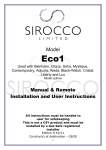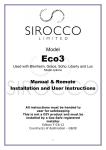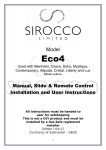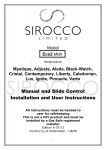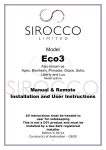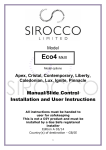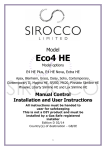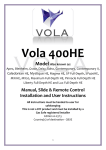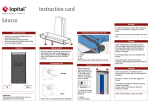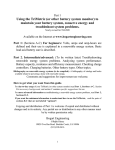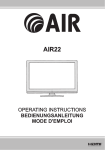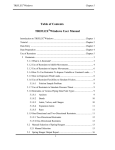Download Manual, Slide & Remote Control Installation and User
Transcript
Model Eco2 Used with Blenheim, Grace, Soho, Mystique, Contemporary, Adjusta, Aleda, Black-Watch, Cristal, Liberty, Caledonian, Lex and Lux Model options Manual, Slide & Remote Control Installation and User Instructions All instructions must be handed to user for safekeeping This is not a DIY product and must be installed by a Gas Safe registered installer Edition K 03/12 Country(s) of destination - GB/IE 1 INSTALLATION INSTRUCTIONS These Notes Must Be Read Before Installation This appliance is an Inset Live Fuel Effect appliance that provides radiant or combined radiant and convected heat; it cannot and should not be used as the main heating source within a property. The appliance is designed to fit most types of fireplaces with a natural draught flue as listed in the Installation Requirements. The appliance must be installed by a competent person in accordance with the Gas Safety (Installation and Use) Regulations 1998. A Gas Safety Registered installer must be used for this purpose. Read all these instructions before any installation takes place and in conjunction with the appliance on site. This appliance must be installed in accordance with the rules in force and only used in a sufficiently ventilated space. This appliance is factory set and tested for operation on the gas type, and at the pressure stated on the appliance data plate. After a new gas appliance (excluding flueless cookers) has been fitted, the Building Regulations in England and Wales require that the installation must be notified to your Local Authority. Your Gas Safe registered engineer needs to do this, failure to register the appliance may affect your warranty. 2 OPENING THE APPLIANCE Stand the carton the right way up, open the box from the top. Read all the instructions before continuing to unpack or install this appliance. Remove the bags containing ceramic components such as coals or gravel etc. Remove the cardboard packing pieces, and any other bags or boxes containing fittings or other parts. When all loose parts have been removed, the appliance may be lifted from the outer carton. Check that the components supplied correlate with the component checklist below. If for some reason any of the listed components are missing or damaged do NOT commence with this installation, in doing so will invalidate your warranty. Please dispose of all the packaging materials at your local recycling centre. CONTENT CHECK LIST Quantity 1 1 1 1 1 1 1 1 1 1 3 Description Firebox and Burner Tray Decorative Trim/Frame Fire Fret/Front Rear Matrix/ Fuel Bed support Front Matrix/ Fuel Bed support Coals/Pebbles Bag of (9 or 14) Ceramic brick panel. Cable fixing kit; 1 cable, 1 tensioner, 1 cable clamps, 3 fixing eyes. Lengths of adhesive sealing strip. Set of manufacturer’s instructions and warranty card. Raw Plugs 3 INSTRUCTIONS CONTENT Section Contents 1 Important Notes 2 Installation requirements 3 Appliance Information 4 Ventilation 5 Site Requirements 5.1 Pre-Fabricated Flue box 6 Debris Space 7 Installation of appliance 7.1 Preparing the Opening 7.2 Fitting the Burner Tray 8 Fuel Bed 9 Fitting The Outer Frame/ Trim 10 Commissioning the Appliance 10.1 Operating the Appliance Manual Control 10.2 Spark Failure 11 Setting Pressure 12 Spillage Monitoring System 13 Testing for Spillage 14 Briefing the Customer 15 Servicing 16 Cleaning the Coals 17 Troubleshooting Guide 18 User Instructions 19 Warranty Details 20 List of Spares Contact details 4 Page No 5 6 7 8 8/9 10 11 11/12 15/17 18/20 21/27 27 27 27 28 28 29 30 31 32 33 33/36 37 44 45/51 51 Section 1: IMPORTANT NOTES This fire is an Inset Live Fuel Effect Gas Fire providing radiant warmth. It is designed to operate on Natural Gas or LPG. It is the LAW that all gas appliances and fittings are installed by a competent person such as a Gas Safe Registered fitter and in accordance with the Gas Safety (Installation and Use) Regulations 1998, the relevant British Standards for Installation, Codes of Practice and in accordance with the manufacturers’ Instructions. The installation shall also be carried out in accordance with the following regulations: The Building Regulations issued by the Department of the Environment, the Building Standards (Scotland) (Consolidation) Regulations issued by the Scottish Development Department. BS 1251 BS 4543 part2 BS 5440 parts 1&2 BS 5871 part 3 BS 6461 parts 1&2 BS 6891 BS 8303 Failure to comply with these regulations could lead to prosecution and deem the warranty Invalid. This appliance must be installed in accordance with the rules in force and used only in a sufficiently ventilated space. Consult all instructions before installation and use of this appliance. The appliance must be registered once commissioned with the regulatory governing body. This appliance is free from any asbestos material. Refractories and coal bed are constructed from ceramic fibre. Note - For Republic of Ireland, reference should be made to the relevant standards governing installation, particularly in regard to flue sizing and ventilation. See IS813, ICP3, IS327 and any other rules in force. 5 Section 2: INSTALLATION REQUIREMENT This appliance MUST NOT be installed into a bathroom or shower room, or where steam may be present. An extractor fan must not be fitted in the same room or space as the appliance as this can affect the safety of the appliance. The fire has been designed to fit into a fireplace or builders opening conforming to BS 1251 (and meeting certain dimensional requirements), or a suitable flue box complying with the constructional requirements of BS 715. A natural draught flue system is required, and if previously used for solid fuel or oil burning, the flue and chimney must be swept prior to appliance installation. The flue must be checked before installation by using a smoke pellet or similar to ensure proper draw and that leakage is not evident at any joints. Repair and re-test as necessary before the appliance is installed. Any flue box used must be installed onto a suitable non-combustible insulating surface at least 12mm thick, covering the entire base area of the box. The flue must have an effective height of at least three metres, as measured from the hearth to the top of the flue. Any flue damper plates or restrictors must be removed and no other restriction fitted to the flue. Where removal is not practical, the restriction must be fixed in the fully open position. The flue must be connected to only one fireplace, and the flue must not vent more than one appliance. There must be no opening in the flue apart from the one that the appliance is installed into, and the one venting the gases into the air. A suitable terminal may be fitted, such as class GC1, as regulations allow. Some of our appliances have been tested for use in a pre-cast block flue complying with BS 1289. In accordance with BS1289 part 1, pre-cast flues built with directly plastered faces (front or rear) are not correctly installed as to ensure proper operation with any type of gas fire. Depending on the flue construction, on occasions the temperature reached can cause cracking of the surface plaster through no fault of the appliance. An air gap or some form of insulation material should be installed to prevent normal flue temperatures from damaging wall surfaces. This appliance is suitable for use with a surrounding area or back panel of 150C minimum rating. 6 Section 3: APPLIANCE INFORMATION Eco2 Hotbox G20 Natural Gas CAT I2H Convector/Super G20 Natural Gas CAT I2H Hotbox Convector/Super Propane (G31) Propane (G31) 20 mbar 20 mbar 36 mbar 36 mbar Max Input (gross) 6.9 6.9 5.9 5.9 Min Input (gross) 2.4 2.4 2.5 2.5 Setting Pressure 20 mbar 20 mbar 36 mbar 36 mbar 8mm Compression 8mm Compression 8mm Compression 8mm Compression Overall Height 595 595 595 595 Overall Width 470 470 470 470 Overall Depth 172 194 172 194 Recess Height 545 545 545 545 Recess Width 348 348 348 348 Recess Depth 178 198 178 198 Air Vent N/A N/A N/A N/A Manual Remote Slide Manual Remote Thermocouple T100/1332 250 Oxy pilot NG 84009079000 Oxy pilot NG 84009079000 Thermocouple T100/1332 250 Oxy pilot LPG 18700/376 Valve CPMM 18700/357 ACS2 LP valve 81104711000 Peerless VCV-89 Linier Valve CPMM 18700/357 ACS2 LP valve 81104711000 Injector MULAK-A MULAK-A MULAK-A BREAY 190 BREAY 190 Gas Group Inlet Pressure Gas Inlet connection Pilot Assembly & Thermocouple 7 SECTION 4: VENTILATION This Appliance does not normally require purpose provided ventilation. However, a second appliance operating within the same room or space must be taken into consideration when assessing ventilation. When commissioning the appliance spillage is detected, then amongst other problems there may be insufficient natural ventilation for correct operation of the flue. If spillage is detected with windows closed, but the appliance does not spill with the windows open, this demonstrates a lack of natural ventilation. If spillage is still detected with the windows open, the flue is at fault. Installation of an air brick is the best solution to lack of ventilation. Any ventilation fitted must comply with BS 5871 part 2 and BS 5440 part 2. Air Vents fitted under or within the immediate vicinity of the appliance must not be used as adverse effects to the operation of the Flame Safety Device (FSD) may occur. Spillage detected during commissioning is almost always a result of poor flue performance that cannot be corrected by any amount of ventilation. For Republic of Ireland ventilation may be required, see IS 813, ICP3, IS 327, and any other rules in force. Section 5: SITE REQUIREMENTS The fireplace opening should be inspected and repairs made where necessary. A chair brick or fireback may be left in place, providing that the dimensional requirements for debris collection space and spigot clearances are met. See diagram below. This appliance requires a natural draught flue system which may be one of the following; 225mm x 225mm (9in x 9in) brick or stone 125mm (5in) minimum diameter lined brick or stone. 125mm (5in) minimum diameter twin wall flue conforming to BS 715. Any existing draught device situated under the fireplace must be sealed off. The opening area must be non-combustible . The appliance requires a hearth with non-combustible surface of at least 300mm in depth and 12mm thick. The top surface must be at least 50mm above the surrounding flooring level, or be surrounded by a raised edge or fender 50mm high. 8 To enable the product of combustion to be cleared properly up the flue, the outlet at the back of the appliance must have a 50mm minimum clearance between it and the back wall of the opening or any other obstruction. The area immediately above the outlet must form a smooth path into the flue. The fireplace or builders open must be reduced to suite the appliance both side to side and the full depth of the appliance, a decorative back panel i.e. marble, granite etc must not be used as a closure plate for the appliance please see below. TOP VIEW Any type of fire surround used with this appliance must be adequately sealed to the wall and floor; a combustible shelf may be fixed to the wall above the fire, providing that it complies with the dimensions given below. From Hearth to Underneath of Shelf with a depth of 150mm is 766mm add 12.5mm in height for every 25mm increase to the projection of the shelf depth. Any combustible side walls must be at least 500mm to the side of the radiant heat source. As with all heating appliances, any decorations, soft furnishings, and wall coverings (i.e. flock, blown vinyl and embossed paper) positioned too close to the appliance may discolour or scorch. Diagram 1 Eco 4 A B C D E F MM Height Width Depth Minimum Hearth Depth in Front of the Fire Heath must Extend Minimum of Minimum Hearth Height 552-575mm 350-455mm 200 Hotbox-230mm Convector 300mm 150mm 50mm B A D 9 C E F Hole-in-the-wall installations Where the appliance is to be installed as a hole-in-the-wall fireplace, a hearth as previously detailed for floor level fireplaces shall be fitted on the floor beneath the hole so as to protect combustible material from heat. However, if a hearth is not to be used, so as to maintain a minimal and contemporary look, the appliance must be installed so that every part of any naked flame or incandescent part of the fire bed is at least 300mm vertically above any carpet or floor covering. When no hearth is to be fitted consideration must be given to fixing a tactile barrier to protect young children, the elderly and the infirm. A tactile barrier can be in the form of a fender, kerb, hearth, shelf or horizontal bar all made from non combustible material and fixed not less than 50mm & not more than 1000mm above the floor level. They should be positioned not less than 300mm in front of the appliance. SECTION 5.1: PREFABRICATED FLUE BOXES This appliance can be fitted into a number of flue boxes provided that the minimum dimensions required for the appliance complied with. The frame of the fire, any back panel or other infill panels, and the flue box must be sealed together so that there is no possibility of leakage between them. The correct clearances to combustible materials (i.e. false chimney breast etc) must be adhered to. The manufacturers’ instructions for fitting the prefabricated box must be complied with at all times. To fit the fire using the cable fixing kit supplied, some minor adaption may be necessary for certain flue boxes. Please ensure the firebox does not obscure the flue box outlet. The firebox, base of the flue box, and hearth below may be drilled to allow plugs and screws to secure installation. It is important that the sealing requirements of the appliance are met at all times and that the flue box is sealed to any back or infill panel. Note: The DEPTH dimension is inclusive of any back or infill panel. 10 Section 6: DEBRIS SPACE In accordance with BS 5871 part 2, minimum debris collection volumes are required behind the installed appliance. CLAY/CEMENT LINES OR BLOCK FLUE WHICH IS NEW, UNUSED, OR PREVIOUSLY ONLY USED WITH A GAS FIRE. Appliance recessed depth + 20mm UNLINED FLUE OR CHIMNEY WHICH HAS BEEN PREVIOUSLY USED FOR A SOLID FUEL OR OIL BURNING APPLIANCE Appliance recessed depth + 60mm Section 7: INSTALLATION OF APPLIANCE Always ensure that the gas supply is isolated before commencing installation of the appliance. The fireplace opening and environment must be in compliance with specifications laid down in the appropriate sections of these instructions. Remove the appliance from its carton as described previously and stand on a dust sheet. Place the coals, ceramics and fixings safely to one side. Remove the manual burner from the assembly by removing the two screws at the base of the burner tray and undoing the connecting nut to the isolation tap. NUT Diagram 3 ISOLATION TAP SCREWS 11 On the slide control option disassemble the linkage by removing the two screws (shown in diagram below), to the slide control then remove the burner from the assembly by removing the three screws at the base of the burner tray and undoing the connecting nut to the isolation tap on the side. 12 The tray is now free and may be lifted away from the box, lift free of the retaining clips on each side of the burner tray. Diagram 4 Carefully remove the spark generator from the box or remove the cables to the generator, making a note of which cable goes where. 13 If this is the Remote controlled version of the this fire then care is needed when removing the burner not to damage the wiring system of the fire, you will need to remove the control box, Heat Shield and battery holder placed at the back of the fire box. Diagram 5 CONTROL BOX HEAT SHIELD You can now decide where to route your gas pipe, knock out holes are provided in the rear and side of the fire box for use where concealed pipe work is required. Knock out the holes with a screwdriver and a sharp tap from a hammer and fit the rubber grommet supplied. On the slide control option the position is located on the opposite side than shown. Note: DO NOT install or use the appliance without this seal in place. Failure to fit this seal correctly will cause the flue suction to act upon the area under the burner tray resulting in poor performance, and overheating of this area. 14 SECTION 7.1: PREPARING THE OPENING Before installing the fire, check the flue for correct operation using a smoke pellet, all of the smoke should be drawn up the flue and exit correctly from the terminal. If problems are found DO NOT fit the fire until corrective measures have been completed. Protect the decorative hearth whilst pushing the convector box in and out of the opening. Part of the packaging or a dust sheet can be used. Before running the gas supply into the opening, offer up the convector box to the fireplace to check the fit is good. Ensure that it slides in correctly, the sealing face sits flat and square to the wall or back panel, and that the base level with the hearth as no leaks are permissible here. At this stage it is essential to ensure that the spigot outlet of the fire is not obstructed in any way. Remove the fire box and apply the self adhesive sealing strips around the edge of the rear of the firebox frame, approximately 5mm in from the edge. CABLE FIXING: Using the template provided, place this within the opening with the bottom edge of the template level with the hearth. Drill 3 x 6mm holes through the template as shown in the diagram and fit the Rawlplugs and screw eyes supplied. Screw Eye Positions 195mm Diagram 6 520 Max 420 Min 115mm Note: In some instances the plastic Rawlplugs supplied my need to be substituted with fibre rawlplugs, if the appliance is likely to heat the screw eyes If the fireplace does not allow for the exact layout shown, the eyebolts should be fixed to give a similar configuration as possible. 15 Thread the tensioning cable through the holes at the top of the firebox, then through the two screw eyes in the top position and then through the one at the lower position, back through the lower hole in the firebox as shown in the diagram. Open out Tab’s with screwdriver to except the cable tie Through holes at the top of the fire box Through Screw eyes Through Screw eye at the bottom and through hole near base of the firebox 16 Push the appliance back into the fireplace, centralise and pull the loose cables through the hole into the firebox Thread the cable tensioner onto the cable as shown, with the nuts screwed down close to the tensioner head. Slide the screwed nipple through the box and pull cable taut and tighten pinch screw on to the cable. Pinch screw Tension nut Adjust tensioner using a suitable spanner to pull the cable tight into position, to allow an even seal around the edge of the fire, visually inspect the seal and reseat if necessary. Surplus tension cable MUST NOT be cut off as this will prevent proper installation after servicing simply coil up the surplus cable as shown and tuck the coils out of the way. Fixing by screw: Mark and drill the fire frame or base, and relevant points in the opening or on the wall. Raw plugs will be required. Note: Fibre Rawlplugs might be preferred rather than plastic Rawlplugs as the heat from the fire might affect their efficiency. Whilst the opening is ready for installation of the fire, the gas supply can be routed as required and connected to the isolation tap via the 8mm compression fitting. Note: In no circumstance should you use soft soldered connections to or underneath the burner tray. 17 The isolator tap or restrictor elbow must be fitted to the incoming supply to facilitate servicing. The gas pipe must be suitably protected where it passes through fireplace openings. Any sleeving should be sealed to the pipe at its ends. The open end of the gas supply pipe should be temporarily sealed to prevent ingress of dust and dirt during installation. At this point if you wish you can remove or fit the polished side cheeks to the fire box. SECTION 7.2 FITTING THE BURNER TRAY Temporarily fit the burner tray and ensure a suitable gas route can be achieved. Ensure the Rear Bracket is Away from the Burner and not impinging upon the flames across the picture. If the fire is the manual control system, you can now place the burner tray into the firebox making sure that the side lugs locate properly on to the side of the firebox. Fit the two securing screws through the front plate ensuring that the plate is in front of the front edge of the fire box. Connect the gas supply and tighten the gas connections. Note: Please ensure that the electrode spark igniters’ gap on the manual version has not been misaligned during the handling of the burner in this installation the gap should be 5mm from the burner. 18 If the fire is the remote control version then carefully place the control box in position with the heat shield in place as per diagram 5 and re-connect the burner tray. Connect the gas supply and tighten the gas connections. With the slide control option please reverse the previous removal instructions taking care to a line the linkage system as shown below. Please note the position on the securing bracket and ensure this is not fixed upside down which will cause the fire not to work. Remote Control options will need the 6 x AA batteries (Batteries are not included, Duracell Plus alkaline battery maybe used or Lithium type batteries can be used) these are to be placed within the holder and connected to the battery lead and the battery heat shield bent to form the cover, to ensure that the battery pack does not overheat. Diagram 8 BATTERY HOLDER COVER FOLD THIS TO MAKE THIS SHAPE 19 Note: Fitting the batteries incorrectly could lead to damaging your control box. Different types of batteries or old and new batteries are not to be mixed. Only batteries of the same or equivalent type as recommended are to be used. Batteries are to be inserted with the correct polarity. Exhausted batteries are to be removed from the fire. The supply terminals are not to be short-circuited. Do not use rechargeable batteries. Non-re-chargeable batteries are not to be recharged. Do not mix old and new batteries. Do not mix alkaline, standard (carbon zinc) or re-chargeable batteries. Diagram 8 a Place Battery Holder and Cover Here Do not place the remote sensor any where above this point. Remote sensor The Sensor MUST be able to be seen when the decorative fascia is in place, the sensor may require relocating when used with alternative Fire Fret/Front. 20 SECTION 8: FUEL BED LAYOUT Place the ceramic rear matrix onto the burner ensuring that the rear matrix is sitting behind the two fixed brackets, the back of the matrix rests against the back panel fitted at the rear or the box. Note: Please ensure that the support brackets are level and that there is a minimum 5mm gap between the burner and the bottom of the rear matrix, this must not be touching the burner as this will cause the fire to burn incorrectly and cause damage to the fire and to malfunction. Place front matrix coal support into brackets fitted 21 BURNER PILOT ASSEMBLY Note: Please ensure that there is a gap between the back of the front matrix and the pilot assembly where applicable, this is to ensure correct operating of the pilot and O.D.S system, this must not be touching the assembly as this will cause the fire to operate incorrectly and cause damage to the fire and to malfunction. FRONT MATRIX Place the front row of 5 coals/pebbles between the front coal support and the rear matrix as shown. Now Place the second row as shown below, coals may be rotated slightly within their positions to give a good visual effect. 22 Now Place the third row as shown below, again coals may be rotated slightly within their positions to give a good visual effect. Note: The coals must not be crammed together, or inserted into the holes in the matrix, a well lay out; generously spaced coal layout will give the best results. Pay special attention to finally adjust the coals with the fire lit on the HIGH setting in order to ensure that no flames play onto the firebox sides. This will reduce the possibility of heat discolouration. 23 Traditional Random coal bed option: First identify the parts please see below: RANDOM COAL FRONT MATRIX 2 X COAL 7 X COAL A 3 X COAL B 2 X COAL C 2 X COAL D E 24 Place the Random Coal Front matrix in place, insuring that it does not touch the pilot assembly behind. Place 5 A Coals between the front matrix and the rear matrix as shown do not block the area between the coal supports. Place the three large coals supports is clear. B as shown again ensuring that the area between the coal 25 Place the two coals C in the spaces left between Coals B. Now place the coals Place the final two D in the top corners as shown below. A coals between coals D 26 Finally place the two small coals E between the A coals at the front on either side and coals B. SECTION 9: FITTING THE DECORATIVE FRAME The appliance is supplied with a decorative frame, the frame attaches to the firebox as a three piece or one piece clip-on unit. Place the magnets supplied to the outer frame of the fire box. A plastic protective coating may be applied to the face of the frame assembly, which should be removed at this stage; the one piece unit can be placed in position. With the three piece unit you should start with the side pieces of the clip-on assembly, these should be pushed into position first, followed by the top bar, which should overlap the sides. IMPORTANT NOTE: Due to the possibility of sharp edges, care should be taken when handling the three piece frame components, the use of protective gloves is recommended. Place the fire front/ fret into position in front of the fire and slide the ashpan door into place. The fire front/fret shown in these instructions may differ from the one supplied with the appliance, we strongly recommend you use a fire front/fret supplied by Sirocco fires as these products will have been tested with the appliance, although other fire front/frets will be compatible. Section 10: COMMISSIONING THE APPLIANCE Turn on and test the gas supply up to the fire for any leaks, in accordance with current Approved Codes of Practice (ACOPs) Section 10.1: OPERATING THE APPLIANCE (See User Instructions Section 18) 27 Section 10.2: SPARK FAILURE The gap between the spark electrode and the pilot should be 3.5 - 4.5mm to produce a good spark. There should be no need to adjust this. If under any circumstances the electric spark fails, the pilot may be lit manually by proceeding with the ignition sequence as previously described, and after turning the control knob through the spark position, the knob should be held in and the pilot lit with a taper. Note: Please ensure that the electrode spark igniters’ gap on the manual version has not been misaligned during the handling of the burner in this installation the gap should be 5mm from the burner. SECTION 11: SETTING PRESSURE Remove the pressure test point sealing screw from the isolation elbow and attach a suitable pressure gauge. Check that the inlet gas pressure is at 20 mbar Working Pressure at 20 Mbar (+/- 1 mbar) Light the pilot and check the correct operation of the burner at all the flame settings. 28 Refer to the Operating instructions section 10.1 Check that the inlet gas pressure is at 20 mbar (+/- 1 mbar), when the fire is at its highest setting. Once the fire has been lit for 5 minutes, turn the gas OFF at the isolating elbow. After a further 3 minutes turn the gas supply ON again, if the gas has stopped flowing, the Flame Supervision Device (FSD) is operating correctly. Always check that the gas has stopped flowing even if you hear the FSD valve close within the 3-minute period. Turn OFF the appliance and the gas supply and refit the pressure test point sealing screw. SECTION 12: FLUE SPILLAGE MONITORING SYSTEM Remote controlled fires are fitted with a flue spillage safety device (ODS). If the fire shuts down during use for no apparent reason then several things may be suspected, if a door or window has been opened creating a draught, then pilot disturbance is the problem, and removal of the draught should resolve this. The gas pressure reaching the fire must also be checked (again, recalls your installer to check and rectify any problem). The thermocouple connection into the back of the gas control valve may also have worked loose during installation, simply get the installer to tighten. If pilot disturbance is not the cause, then the ODS safety system may be in operation. Switch the appliance OFF, check the flue and carry out any remedial work required. Relight the fire and carry out a spillage test, DO NOT allow the appliance to be used if it continues to fail a spillage test. The aeration hole of the pilot must be carefully cleaned out on each annual service to ensure continued function of the ODS. The spillage monitoring system shall not be adjusted, modified, or put out of operation by the installer. Any spare parts fitted MUST be of a type supplied for the purpose by the appliance manufacturer. If the fire is not spilling, then further guidance should be sought, using the Troubleshooting section as a guide. 29 SECTION 13: TESTING FOR SPILLAGE Close all doors and windows to the room containing the appliance. Let the fire run on HIGH for five minutes. Take a smoke match, light it, and using a smoke match tube, hold it at the top edge of the fire opening, 25mm down and 25mm in. Run the smoke match across the opening, all the smoke should be drawn away up the flue. Any smoke returning into the room indicates that spillage is occurring. If the initial spillage test fails, run the fire for a further 10 minutes and repeat the test. Please Note: If using the Super Convector firebox and the spillage test fails please remove the spigot restrictor making sure to replace the screws back in to their positions and re-test. When the test has been completed satisfactorily, repeat with any extractor fans in the premises running on the highest setting, and any communicating doors open. Finally, repeat with all doors open. DO NOT allows the fire to be used until the test is satisfactorily passed. 30 SECTION 14: BRIEFING THE CUSTOMER All instructions must be handed to the user for safekeeping. Show the customer how to light and operate the fire. After commissioning the appliance, the customer should be instructed on the safe use of the appliance and the informed for the need of regular servicing. Frequency of service depends on usage, but MUST be carried out at least once annually. Cleaning of the fire may be achieved when the fire is cold using a damp cloth and mild detergent on most surfaces, with the exception of the ceramic fuel bed. A soft brush i.e. paint brush may be used to clean the ceramic fuel bed taken care not to use excessive pressure. Scratched and other superficial damage to the matt black paintwork of the appliance can be covered with matching heatproof spray. Use only the manufacturers’ recommended spray paint. Paint only when the fire is OFF and cold. Always mask off the surrounding area to prevent contamination with overspray. Ventilate the room during the use of the spray. DO NOT attempt to spray paint the coals or ceramics, or wash them in water. Advise that the fire will emit a “newness” smell for a time after initial commissioning and that extra ventilation may be needed during this time. Advise that the fire is fitted with a spillage safety device (O.D.S.). If the fire shuts down, this system may be in operation. If spillage is suspected, SWITCH APPLIANCE OFF and call in the installer to investigate any problems. 31 SECTION 15: SERVICING Isolate the fire from the gas supply. Ensure that the fire is fully cold before attempting service. A suggested procedure for servicing is detailed below: 1. Lay out the dust sheet and tools required. 2. Remove the cast front fret. 3. Carefully remove the ceramic components 4. Remove the two screws that retain the tray in place and disconnect from the isolation tap. 5. Remove the burner tray and other components as required (i.e. remote control box) 6. Disconnect the gas supply, to the appliance and disconnect the isolation tap 7. Remove convector box by, firstly protecting the hearth from potential damage, unroll the coiled tensioner cables from the rear of the firebox, remove the securing nipples and tensioner adjusters, the firebox is now released from the opening and can be slid outward onto the hearth. 8. Check the fireplace opening for rubble accumulation and remove, if debris is excessive, initiate remedial work on the flue. 9. Check the flue with smoke pellet for correct operation. 10. Refit convector box using new seals where necessary 11. Strip off the burner pipes and clean thoroughly. 12. Clean out the injector, pilot assembly and burner tube. DO NOT remove the pilot injector. 13. Re-assemble and re-fit the burner tray. 14. Turn on the gas supply, and leak test. 15. Refit the decorative casting and ceramics. 16. Check any purpose provided ventilation is un-obstructed. 17. Light the fire and test for spillage. 18. Check setting pressure and safe operation of the appliance. 32 SECTION 16: CLEANING THE COALS Remove the fire front/fret casting and place to one side. Remove the ceramic components. Gently clean in the open air using a dry paint brush. Be careful not to create dust from the coals. Where necessary replace damaged components with genuine spares. Seal scrap ceramic components in plastic bags and dispose at proper refuse sites as directed. Re-fit the coals by referring to the relevant sections of these instructions. SECTION 17: TROUBLESHOOTING GUIDE Manual and Slide Fire sparks but pilot Flame does not light? No gas to fire, check isolating valves are open. Pipe work blockage, clean out. Air not fully purged, re-purge supply or wait longer. Spark earthing to metal work, reset gap correctly. Blocked pilot, clean out internally. A pilot light but then goes out before main burner lights? Severe restriction in gas supply, clear obstruction. Faulty thermocouple, replace pilot unit. Hold control knob in for longer. Run through lighting system on the remote control several times allowing the valve to rest each time. Fire does not spark at pilot? HT lead detached, refit. Spark gap too large or small reset correctly. Spark shorting to metalwork under tray, re-align HT lead Fire runs for a time and then cuts off? Excessive room draught or flue pull, rectify. Loose or faulty thermocouple, rectify. O.D.S system in operation. Firebox grommet seal not fitted, rectify. 33 Lint in pilot aeration hole, clean thoroughly internally Pilot flame shrinks when fire is on high? Poor gas flow to fire, check pressure with fire on high. If pressure is low, remove any restriction in pipe work or valve. Check all isolators are adequately sized and fully open. Check meter pressure is adequate. Air leak under base of firebox, rectify. Lint in pilot aeration hole, clean thoroughly internally. Firebox grommet seal missing, rectify Fire smells when first lit or in use? Newness smell from brand new appliance. Spillage occurring, call installer to carry out spillage test and rectify any problems. Low temperature sealants or combustible materials used in incorrect positions. Air leak under base of firebox, rectify Firebox grommet seal missing rectify. Remote control Remote Control Diagnostic "Beeps" Do not mix battery types 3 "beeps" Replace handset or dummy switch 4 "beeps" Replace Gas Valve 5 "beeps" Replace EDB control box Battery below required power replace all 6 "beeps" batteries in the appliance 7 "beeps" Battery below required power replace all batteries in the appliance do not use ZINC batteries Battery life tests show that Duracell batteries discharge at higher rates when exposed to heat despite their reputation for longer life Ever ready Energiser industrial are regarded as one of the best available. To get back to a stable reference condition, remove the battery pack and wait 10 minutes for the internal capacitor to discharge. Reconnect the battery pack and carry out an ignition attempt, short cutting this procedure can give a false indictor. 34 No Operation For correct operation the handset light should flash and the EDB (control Box) should emit a single beep 1 Check main battery pack, if low it will Beep continuous - 7 "beeps"= low Charge, 6 "beeps"= Discharged batteries. In both cases change the battery, if using 6 x AA change all batteries and ensure that types are not mixed, it is recommended to use alkaline or lithium, also ensure the batteries are correctly positioned within the holder, in some cases it may be necessary to start the ignition sequence to clear the beep fault code, and start a second time. 2 Check the battery in the hand set and change if necessary. 3 If the appliance emits 3 "beeps", this indicates a faulty handset. Replace handset or this may also indicate dummy switch might need replacing. 4 Ensure the IR receiver in the fire is visible and the handset can deliver a "line of sight" signal to the receiver, for maximum range the receiver should be vertically positioned, reposition if necessary 5 IR receiver lead is not connected or receiver is damaged, check and replace if necessary. 6 Faulty EDB Control box Replace if necessary Gas Valve does not open 1 Faulty gas valve-appliance will emit 4 "beeps" replace if necessary 2 Gas valve lead not connected check and rectify 3 Faulty EDB replace if necessary No Spark at Pilot Tip 1 Electrode Broken check and replace if required 2 Electrode lead damaged or disconnected check and replace if necessary. 3 Incorrect spark gap, check gap is between 2.5mm to 4mm Spark short circuits to appliance metalwork, ensure lead is correctly routed, NOTE: it is 4 normal for some sparks to discharge within the EDB (control box). 35 5 Faulty EDB replace if necessary Pilot Does Not ignite. No gas at the appliance check supply is present , check flow through isolator. Air in system, it may take several ignition 2 attempts to purge system 1 3 Debris in pilot line check and clear if necessary 4 Faulty EDB replace if necessary Faulty Gas valve, is the gas valve open? Replace 5 if necessary Main Burner Does Not Ignite Pilot goes out after 20 seconds. This faulty 1 generally indicates a problem with the thermocouple flame/sensor check the pilot hood is squarely fitted and the 1a pilot flame has good envelopment of the thermocouple tip. 1b Ensure the pilot is not disturbed by airflow into the appliance or draughts from the flue. Ensure thermocouple is properly connected to the 1c valve hand tighten thread and tighten 1/4 turn with spanner. 1d Faulty thermocouple, replace pilot assembly if necessary 1e Faulty EDB - internal flame sensing replace if necessary. 2 Blocked burner injector check flame and rectify 3 Faulty gas valve replace if necessary 4 Faulty EDB replace if necessary. 36 SECTION 18: USER INSTRUCTIONS IMPORTANT NOTES The installation of this fire MUST only be carried out by a competent person (such as a Gas Safe registered fitter) in accordance with the Gas Safety (Installation and Use) Regulations 1998, the relevant British Standards, Codes of Practice, the Building Regulations and the manufacturers’ instructions. Failure to comply with the above recommendations could lead to prosecution and invalidate the appliance Warranty. Please ensure you are handed all of the manufacturer’s documents on completion of the installation. This will include these instructions. Always keep a note of the installer’s name and address, the original purchase receipt and the date of installation for future reference. The fire and flue should be serviced regularly to ensure continued safe operation. See the servicing section for further details. Frequency of service will depend on use, but MUST be carried out at least once annually. Parts of this appliance become naturally hot during use. It is recommended that a suitable fire guard conforming to BS 6778 is used, especially where young children, the elderly, or infirm are concerned. Combustible items, such as flooring and furniture, and soft wall coverings (such as blown vinyl or embossed paper) may discolour if fitted too close to the fire. See relevant section for further details on clearances to combustibles. No combustible material or flooring should protrude onto the hearth. DO NOT burn any foreign material on this fire, the coals must be of the correct type and lay out in accordance with the relevant section of these instructions. Failure to do so could create a hazard or lead to sooting. Before the appliance is installed, the chimney should be swept. All flues should be checked by the installer to ensure there are no defects or obstructions that may prevent the flow of combustion products. The fire is only suitable for use with the gas type for which it is supplied. This fire is supplied with a particular style of fire front/fret. Use of the fire front/fret will ensure an adequate airflow under the fire bed for the correct functioning of this appliance. Compliance with safety standards cannot be guaranteed if another style of front is used. 37 A combustible shelf may be fixed to the wall above the fire, providing that it complies with the dimensions given in section 3 site requirements. No purpose provided ventilation is normally required for this appliance. The requirements of other appliances operating in the same space or room, and the results of a spillage test must be taken into consideration when assessing ventilation requirements, this will have been carried out by your Gas Safe registered installer. For Republic of Ireland, ventilation may be required, see IS 813, ICP3, IS 327, and any other rules in force. OPERATING THE APPLIANCE (Manual Control) For your safety, the fire is fitted with a Flame Supervision Device (FSD), which will shut off the Gas supply if for any reason the pilot is extinguished. This device incorporates a fixed probe, which senses heat from the pilot burner flame, if the probe is cooled, the device will prevent any gas flow. If for any reason the flames go out or if the fire has been turned off for any reason, always WAIT FOR 3 MINUTES before attempting to re-light. The pilot is visible through the Fuel bed at the front of the fire; rotate the coals for good viewing. Push in and turn the control knob to the SPARK position, and hold there for a few seconds. Continue turning anti-clockwise through the spark click to the PILOT light position, ensuring that the control knob is depressed and the pilot has lit. If not, return the knob clockwise, and repeat. OFF IGNITION LOW HIGH When the pilot lights after the spark, keep the knob depressed for approximately ten to fifteen seconds. Now release the knob and the pilot should stay alight. If the pilot is extinguished during use, wait three minutes before repeating the ignition procedure. To achieve the HIGH setting, push the control knob in slightly and continue turning anticlockwise to the high position. 38 The main burner should light after a few seconds, to decrease the setting to LOW, turn the control knob clockwise to the low setting. To turn to the PILOT position from the HIGH or LOW positions, press the control knob in, and return to the pilot position and release. To turn the fire OFF, keep the control knob depressed, and return to the off position and release. OPERATING THE APPLIANCE (Slide control) For your safety, the fire is fitted with a Flame Supervision Device (FSD), which will shut off the Gas supply if for any reason the pilot is extinguished. This device incorporates a fixed probe, which senses heat from the pilot burner flame, if the probe is cooled, the device will prevent any gas flow. If for any reason the flames go out or if the fire has been turned off for any reason, always WAIT FOR 3 MINUTES before attempting to re-light. The pilot is visible through the Fuel bed at the front of the fire; rotate the coals for good viewing Fit the 9V battery in to the battery holder under the fire tray or at the back of the fire box. 39 1. From the standing position push the thumb control all the way to the bottom where a spark will be heard and generated, hold down for approximately 15 seconds. 2. Release the pressure and the pilot light should now be established (if this fails repeat step 1 and hold down for 20 seconds). 3. Slide the control upwards to increase the flame size to the desired effect. 4. To switch the fire off simple slide the control upwards, passed the positive stop and hold for 2 seconds. 40 OPERATING THE APPLIANCE (Remote control) For your safety, the fire is fitted with a Flame Supervision Device (FSD), which will shut off the Gas supply if for any reason the pilot is extinguished. This device incorporates a fixed probe, which senses heat from the pilot burner flame, if the probe is cooled, the device will prevent any gas flow. If for any reason the flames go out or if the fire has been turned off for any reason, always WAIT FOR 3 MINUTES before attempting to re-light. The pilot is visible through the Fuel bed at the front of the fire; rotate the coals for good viewing Fit the batteries (all components are to be found in the bag containing these instructions) Fit a 9V battery in the hand set by pushing in the tab on the back of the hand set and pulling up, locate the battery. Fit the 6 AA batteries in the holder following the sequence as shown on the holder then attach to the cable on the fire using the press connection and cover with the heat shield as described in Dia.8. To light the fire, point the handset to the sensor on the front your fire. Press and hold the two buttons together, on the left hand side of the handset. The fire will give out a beep sound and you can release the buttons. After a few seconds you will hear the spark clicking spark to the pilot light. Once the pilot is lit the fires main burner will come on to the high position (this whole process will take no more than 20 seconds). To turn down the fire, point the handset to the sensor on your fire then push and hold the minus button (small flame), if you release immediately the flame will go to low if you keep holding the flame will lower slowly and you can release the button to your desired position. 41 The fire may be left in the standby mode (pilot only) by pressing the small round button on the handset. To turn your fire off, point the handset at the sensor and push the top left button and hold. The fire will go out. CHANGING THE BATTIERIES 1. 2. 3. 4. 5. Detach the battery holder from under the fire. Remove the batteries from the holder. It is recommended to replace all the batteries at the same time. Ensure the replacement batteries are placed in the holder correctly. Wait at least 15 minutes before re-attaching the battery holder, this will allow the control box and the gas valve to reset to a default setting. 6. Remote Control fires will need 6 x AA batteries (Duracell Plus alkaline battery maybe used or Lithium type batteries can be used) Note: Fitting the batteries incorrectly could lead to damaging your control box. Different types of batteries or old and new batteries are not to be mixed. Only batteries of the same or equivalent type as recommended are to be used. Batteries are to be inserted with the correct polarity. Exhausted batteries are to be removed from the fire. The supply terminals are not to be short-circuited. Do not use rechargeable batteries. Non-re-chargeable batteries are not to be recharged. Do not mix old and new batteries. Do not mix alkaline, standard (carbon zinc) or re-chargeable batteries. 42 CLEANING Before carrying out any of the following operations, ensure that the fire is OFF and completely cold. Debris that may form on the fire bed should be periodically removed by a competent person. Large deposits could indicate deterioration of the flue. This should be repaired by a competent person, and the fire serviced before further use. FIRE FRONT/FRET - Any dust accumulating in the fire front may be removed using a vacuum cleaner or dry cloth. Heavy stains may be removed by using a damp cloth and mild household detergent. Brass parts of the fire front may be cleaned using a suitable brass cleaner. Replace the front centrally against the fire after cleaning. PAINTED AREAS - These can be cleaned using a dry cloth. COALS AND CERAMICS See the relevant section in the Installation Guide of these instructions. SERVICING The fire and flue should be checked on an annual basis to ensure all of the products of combustion are entering the flue and that there is no excessive build up of soot. The frequency of service will depend on usage, but MUST be carried out at least once annually. Servicing must be carried out by a competent person, such as a Gas Safe registered installer. Cleaning of the coals may be carried out by following the instructions given in the Installation section. The Installation instructions carry full servicing details for the use of the installer. If debris from the flue or other foreign matter is found on the fire it may indicate a need for servicing. Do not use the fire until the source of the debris has been found and rectified. Air vents (where fitted) should be checked periodically to ensure they are free from obstruction. 43 SECTION 19: WARRANTY IMPORTANT INFORMATION ABOUT WARRANTY SERVICE FOR THE END USER WARRANTY REGISTRATION IS REQUIRED WITHIN 28 DAYS FROM DATE OF PURCHASE It is in your interest to register your appliance with Sirocco as soon as possible BEFORE CONTACTING SIROCCO FOR SERVICE PLEASE READ THE FOLLOWING; Sirocco is committed to customer care and service. To ensure we provide the best service we can we have a policy to charge for all none warranty home visits so that all customers with a genuine manufactures fault can be dealt with swiftly, if your appliance has recently been installed and you are experiencing any of the following; Fumes are spilling from the flue/fire The pilot light cuts out after a few minutes The fire controls are getting too hot Excessive sooting is forming on the fuel bed Poor flame picture Remote controls are not working These symptoms tend to be chimney/flue or installations related and as such mostly are not covered by your warranty and are mostly dealt with in the installation instructions, DO NOT USE YOUR APPLIANCE and in the first instance contact your installer to investigate these further, to establish their cause before contacting Sirocco. CONTACTING SIROCCO FOR WARRANTY SERVICE OR TO PURCHASE SPARE PARTS In the event of a service or parts claim please note that some parts such as ceramics, batteries, trims and fronts etc are categorized as “user serviceable parts’ and are not carried out by a service visit. Please ensure you have the following information at hand when you contact Sirocco; The full serial number which is located on the data badge of the appliance Your receipt of purchase showing the date and where purchased from Your installers details You can contact Sirocco`s representative in the UK by phone to obtain advice and a warranty service form on; 0843 289 4268 Or you can complete a form on line at www.siroccofires.com follow the link at the top right hand side on the home page. SIROCCO Sp. Zo.o Nad Lasem 8, Zelecow, 96-321 Zabia Wola, Poland. Tel 0048 22 425 8681, Fax 0048 46 857 8559. Further information, contact details and email facilities are available through our website; www.siroccofires.com 44 SECTION 20: LIST OF SPARES Eco 2 Manual Control 45 Eco 2 Slide Control 46 Eco 2 Remote Control 47 Eco2 Ceramics 48 Eco2 Ceramics 9A 10A 49 code SPARE PART DESCRIPTION PARTNUMBER 1A FRONT MATRIX E2 PRT CER MX/F ECO 2 BLK 2A REAR MATRIX E2 black PRT CER MX/RE ECO 2 BLK 3A REAR MATRIX E2 grey PRT CER MX/RE ECO 2 GRY 4A COAL SET E1-2-3-5 (14 PCS) PRT CER CO ECO 1.2.3.5 BLK 5A PEBBLE SET E1-2-3-5 (granite grey 14 pc) PRT CER PB ECO 1.2.3.5 GRY 6A PEBBLE SET E1-2-3-5 (sandstone yellow 14 pc) PRT CER PB ECO 1.2.3.5 YEL 7A PEBBLE SET E1-2-3-5 (grey & Yellow mixed 14 pc) PRT CER PB ECO 1.2.3.5 MIX 8A BACK BOARD ECO 2 PRT CER BB ECO 2 BLK 9A RANDOM FRONT MATRIX E2 PRT CER FM E 2 RC 10A RANDOM COAL SET PRT CER FC R 1B SPARK ELECTRODE INC FIXING SCREW PRT VAL SP UN M IS 0 2B THERMOCOUPLE INC LOCK NUT PRT VAL TP UN M CO 0 3B ISOLATION/PRESURE TEST POINT VALVE INC NUT & OLIVE PRT VAL IS UNI 0 PR 0 FIXING KIT PRT FIX FK E1-5 0 SI 0 INSTALLATION & USER MANUAL ALL MODELS PRT DOC 6B CONTROL VALVE KNOB (PACK X 2) PRT VAL KN 7B CONTROL VALVE (NATURAL GAS) PRT VAL 8B CONTROL VALVE (LPG GAS) PRT 9B INJECTOR (NATURAL GAS) 10B 11B ECO 2 BLK 1 SI UNI 0 POL 15 CV ECO NG CO M VAL CV ECO LP CO M PRT VAL IJ E1,2,3 A MUL NG INJECTOR (LPG GAS) PRT VAL IJ E1,2,3 LP MUL LP BURNER (NATURAL GAS) PRT VAL BR E2 NG AE 41M BURNER (LPG GAS) PRT VAL BR E2 LP AE 41M 13B ENGINE NATURAL GAS (MANUAL) EXCLUDING CERAMICS PRT ECO 2 N M ENGINE 14B ENGINE LPG GAS (MANUAL) EXCLUDING CERAMICS PRT ECO 2 LPG M ENGINE 15B GAS INLET TUBE PRT VAL TU ECO 1-5- 1C ENGINE (REMOTE) EXCLUDING CERAMICS PRT ECO 2 N RC 2C RECEIVER PRT VAL RC UN RE SIT 1 3C HT LEAD PRT VAL RC UN HTL SIT 2 4C DUMMY SWITCH PRT VAL RC UN DS SIT 3 5C EDB LP VER.5 CONTROL BOX PRT VAL RC UN EDB SIT 4 6C REMOTE HAND SET PRT VAL RC UN RH SIT 5 7C ACS2 LP VALVE PRT VAL RC UN VAL SIT 6 8C PILOT GAS TUBE 4MM PRT VAL TU PI E SI 10 9C GAS INLET TUBE 8MM PRT VAL TU VI E MUL 1 10C BATTERY LEAD PRT VAL RC UN BL SIT 7 11C BATTERY HOLDER PRT VAL RC UN BH BCL 0 12C PILOT REMOTE NG PRT VAL RC UN PL SIT 8 13C PILOT REMOTE LPG PRT VAL RC UN PL SIT 9 50 IM E SI 1M 1 ENGINE 14C THERMOCOUPLE TO VALVE CONNECTION PRT VAL TH RE CT SIT 1 15C BURNER (NATURAL GAS) FOR REMOTE CONTROL PRT VAL BR E2 NG AE 42R 16C BURNER (LPG GAS) FOR REMOTE CONTROL PRT VAL BR E2 LP AE 42R 17C INJECTOR (NATURAL GAS) PRT VAL IJ E1,2,3 A MUL NGR 18C INJECTOR (LPG GAS) PRT VAL IJ E1,2,3 LP MUL LPR TRIM 3 PART BRASS PRT DCF TR ECO 3PR SK BR TRIM 3 PART CHROME PRT DCF TR ECO 3PR SK CH 1D ENGINE (SLIDE) EXCLUDING CERAMICS PRT ECO 2 N SL E 2D SLIDE CONTROL MECHANISM ASSEMBLY C/W LINKAGE PRT VAL SL UN MC SI 1 3D PILOT GAS TUBE 4MM complete with nuts & olives PRT VAL TU PI SL SI 2 4D GAS INLET TUBE 8MM complete with nuts & olives PRT VAL TU IN SL SI 1 5D PILOT REMOTE NG PRT VAL PI RO PL SIT 1 6D THERMOCOUPLE LEAD VALVE TO SWITCH PRT VAL TH RO CT SIT 2 7D GAS INLET TUBE 8MM C/W INLET ELBOW, NUTS & OLIVES PRT VAL TU IN SL SI 2 8D INJECTOR (NATURAL GAS) PRT VAL IJ 2 UN MU NGR 9D BURNER (NATURAL GAS) FOR SLIDE CONTROL PRT VAL BR E2 NG AE 1 10D H T LEADS X3 for spark generator PRT VAL SL UN NG SI 1 11D SPARK GENERATOR PRT VAL SG UN NG TC 1 12D MICRO INTERRUPTER SWITCH PRT VAL IS UN 0 BC 2 13D PEERLESS VCV-89 LINIER VALVE PRT VAL SL UN 0 PL 1 14D HEAT SHEILD PRT VAL SL UN 0 HS 1 SECTION 21: CONTACT DETAILS SPARE PARTS If you need assistance or wish to purchase spare parts 08432 890102 Mon to Fri 9:00 to 16:00 Contact our spares department by email [email protected] Purchase spare parts direct from our website www.siroccofires.com Spare parts are managed by our UK partner company Lodestar-Delta Ltd Lodestar-Delta Ltd T/A Sirocco Unit 1, 11 Weir St, Blackburn, Lancashire BB2 2AN SIROCCO HEAD OFFICE Telephone number for all departments 0843 289 4268 (charged at BT national rate) Mon to Fri 10:00 to 15:00 Contact us by email [email protected] View our latest products and use our on line services; www.siroccofires.com 51 - 0 Nad Lasem 8, Zabia Wola 96-321 Zelechow Poland TECHNICAL HELP LINE Speak to a Sirocco trained engineer 0904 0843473 (0904 084 FIRE) This is a premium rate number charged at 1.00 plus vat per minute from BT lines Mon to Fri 9:00 to 17:00 WARRANTY AND SERVICE For warranty registration or for a home service call: www.siroccofires.com For assistance to complete a registration or a home service call us on 08432-890102 Mon to Fri 9:00 to 16:00 Our warranty statement CONDITIONS OF GUARANTEE Sirocco (hereinafter referred to as the company) will, at its option, repair or replace free of charge any product or part thereof which is shown to the satisfaction of the company to be defective due to faulty materials or workmanship within 12 months from the date of purchase, subject to the conditions set out below: 1. Gas fire installation and commissioning must be carried out by a GAS SAFE registered engineer that has a valid and relevant qualification to work on such appliances in accordance with the installation instructions supplied with the product. 2. The warranty registration form must be correctly completed and returned to Sirocco within 28 days from date of purchase 3. A valid and correctly completed installers Commissioning Declaration form (as supplied in the warranty registration form) relating to the installation of the product must be presented to the company in respect of any claim under this guarantee. 4. A CP1 form must be completed on commissioning the appliance and registered with GAS SAFE 5. The product must only be operated in accordance with the user instruction book. 6. The installation must be in accordance with the installation instructions and comply with all current legislation and building regulations. 7. The guarantee commences from date of purchase. A proof of purchase is required as part of the validation to receive a warranty service. A sales receipt showing the original date of purchase is considered proof of purchase no other documentation will not be accepted. 8. The guarantee shall not cover any fault or defect caused by faulty installation, including failure to observe the installation instructions supplied with the product. Accordingly the company will charge a fee to cover the cost to the company of travel and/or time spent to rectify a product which is incorrectly or improperly installed and for any parts that may have been so damaged due to this. The company will advise the amount of such fee and take your credit or debit card details prior to our engineer’s visit. The fee will be charged to your credit or debit card if the defect is other than a manufacturing fault. 9. The guarantee is non-transferable and is made to the first retail purchaser provided that the sale is made through an approved company stockist. 52 10. Any installation labour transportation or other related costs/expenses arising from defective parts/rapier replacement or otherwise of same will not be covered by this guarantee nor shall the company assume responsibility for same. Furthermore the company shall not be responsible for any indirect or consequential damages except as provided by law. 11. The appliance must be kept free from dust, dirt and debris by the user, in accordance with the cleaning instruction 12. All other guarantees expressed or implied with respect to the product, its components, and accessories or any obligations/liabilities on the part of the company are hereby expressly excluded so far as permitted by law. 13. The company neither assumes nor authorises any third party to assume on its behalf any other liabilities with respect to the sale of the appliance. 14. The guarantee does not apply to other non Sirocco products such as prefabricated flue boxes and flues. 15. The company will not be responsible for: (a) Inadequate or inappropriate flueing, chimneys etc; (b) down drafts or spillage caused by environmental conditions such as nearby trees, buildings, rooftops, hills or mountains; (c) inadequate ventilation or negative air pressure caused by mechanical systems such as extraction fans, cooker extraction hoods, clothes driers etc 16. The guarantee is void if: (a) the fire has been operated in atmospheres contaminated by chlorine, fluorine, or other damaging chemicals; (b) the fire is subjected to long periods of dampness or condensation. 17. The guarantee shall not cover: (a) any damage to the combustion chamber or the heat exchanger or other components due to water or weather damage which is the result of, but not limited to improper chimney/venting installation; (b) any fault or defect caused by failure to observe the user instructions supplied with the product or by any alteration, modification, wilful abuse, accident, careless operation or missuse of the product or by any external sources e.g. transit damage or weather.. 18. The guarantee will not cover an appliance that has been found damaged or incomplete prior to installation but is there after installed without being corrected by sirocco beforehand or removed from the installation prior to Sirocco inspecting. 19. The guarantee will not cover an appliance that has been subsequently removed without Sirocco having the opportunity to inspect the appliance or without the prior written consent of Sirocco 20. Validation of your installation will be required prior to warranty service/repair; there will be a fee for this. No other validation will be accepted by Sirocco. 21. The guarantee shall not cover: (a) surface crazing of fibre components e.g. matrix, coals liners etc; (b) batteries; (c) cosmetic blemishes to polished metal and painted surfaces. 22. Some components are categorised as “user serviceable parts” and will not be carried out as a service visit, these include ceramic components, decorative trims and fronts, batteries, some electrical and electronic components etc 23. Repairs carried out under the guarantee do not extend the guarantee period. Any parts removed during guarantee repairs become the property of the company. 24. The guarantee is in addition to, and does not affect, your statutory and other legal rights. In Addition to the above the following terms and conditions apply to extended 5 year warranty; 25 Extended 5 year parts warranty has to be issued by an appointed Sirocco Premier stockiest, no other stockists are authorised to issue these warranties 26 The warranty approval number issued by the stockist must be entered at the time of registration (this can be completed on our website) 27 The extended warranty gives an addition 4 years parts only warranty commencing from the 1 st anniversary of the date on purchase, this is limited to the repair or replacement of parts found to be defective in material or workmanship only after confirmation of the defect by a Sirocco engineer or an appointed Sirocco engineer, provided that such parts have been subject to normal conditions of use 28 Any installation, labour, transportation or any other related or expenses arising from defective parts, repair or otherwise of the same are not covered by this warranty, nor shall Sirocco assume responsibility for any incidental indirect or consequential damages, except as provided by law. 29 It is essential that your Sirocco appliance is serviced, by a suitably qualified Gas Safe engineer or a Sirocco authorised appointed engineer to carry this out at least every twelve months, as part of your 5 year warranty in addition the flame failure devise or ODS and ceramics on some models will need to be replaced in the 3rd year service as part of the conditions of your 5 year warranty, these items are purchased from the Sirocco 53 internet website “Spares shop” and are shown as 3rd year service packs, the invoice for these items must be provided at the time of making the claim. 30 The service log found in the installation instructions must be completed by the service engineer at the time of the service and an appropriate invoice issued for this and supplied to Sirocco on any claim being made under the warranty 31 The following are not covered by this extended warranty: paint work in the fire chamber, fire fronts, and decorative trims, ceramic components, glass and batteries, electronic or electric/mechanical components such as remote controls. Issue; 21/10/11 54






















































